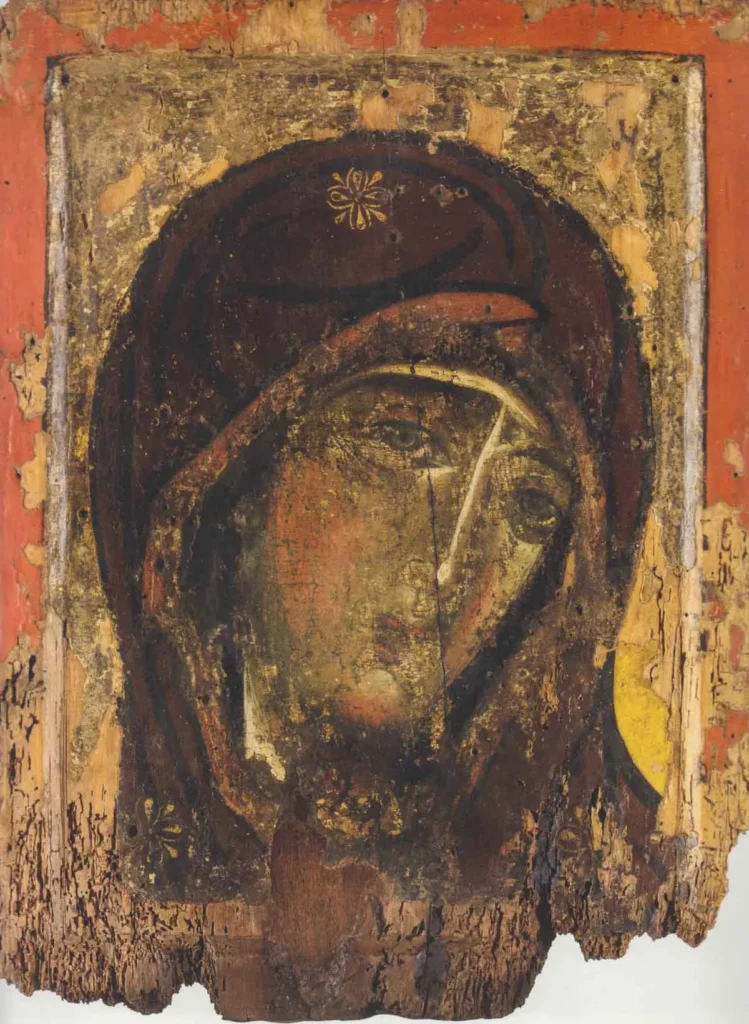Kathreptis (Mirror) Icon

Nestled within the sacred confines of Monastery of Saint Paul (Agiou Pavlou) on the spiritual peninsula of Mount Athos, resides the Icon of Virgin Mary Kathreptis, known as the “Mirror”. This venerated icon, steeped in history and mystique, holds a place of reverence both in religious devotion and in the realm of Byzantine artistry.
The “Kathreptis” or “Mirror” is not just a title; it is a testament to the icon’s intriguing past and miraculous narrative. According to tradition, the icon was once the possession of the Byzantine Empress Theodora, renowned for her pious resistance to iconoclasm. It earned its name from a unique tale of concealment and divine protection, where it was hidden behind a mirror to escape destruction during a period of religious turmoil.
Located in one of the twenty monasteries of Mount Athos, the Icon of Virgin Mary Kathreptis at Agiou Pavlou Monastery continues to be a focal point of veneration and admiration.
Historical Background
The Icon of Virgin Mary Kathreptis, enshrined in Agiou Pavlou Monastery, bears a rich historical tapestry that dates back to the Byzantine Empire, intertwined with the reign of Empress Theodora and the turbulent era of iconoclasm.
Connection to Empress Theodora
Empress Theodora, the wife of the iconoclast Emperor Theophilos (829-842), played a pivotal role in the history of the Kathreptis icon. Known for her staunch defense of the veneration of icons, Theodora’s reign marked a significant period in the Byzantine Empire, where religious art and iconography were at the center of theological and political strife. The Empress, revered for her piety and resolve, became a key figure in the preservation and restoration of icons within the empire.
The Story Behind the Name “Kathreptis”
The name “Kathreptis”, meaning “Mirror” in Greek, is rooted in a tale of cunning concealment and divine protection. During the height of iconoclastic persecution, when holy icons were being destroyed, Empress Theodora sought to protect this precious icon. It is said that she concealed it behind a mirror in her private chamber, a strategic move that shielded the icon from the iconoclasts’ wrath.
Miraculous Survival from Iconoclast Attacks
Despite the efforts to destroy religious icons, the Kathreptis icon miraculously survived the iconoclastic period, bearing witness to a time when the very existence of such sacred art was under threat. The icon seems to have retained scorch marks on its upper section, a physical testament to its survival from attempted destruction by fire.
The enduring presence of the Kathreptis icon serves as a powerful reminder of the resilience of faith and the enduring significance of holy icons in Orthodox Christianity. Its survival is not just a historical fact but a symbol of the triumph of religious expression over suppression.
Physical Attributes
Depiction of the Virgin Mary
The icon portrays the Virgin Mary with a serene yet poignant expression, her head slightly tilted to the right. This gentle inclination of her head adds a human touch to her divine depiction, evoking a sense of maternal grace and compassion.
Silver Riza
In later periods, particularly the 18th and 19th centuries, the icon was encased in a silver riza, a protective ornamental cover. This addition left only the Virgin’s face exposed, a common practice in the preservation and veneration of sacred icons. The riza not only protects but also adds an element of reverence and splendor to the icon.
Symbolic Elements
Star-Shaped Details
The star-shaped details adorning the Virgin Mary’s garment are laden with symbolism. Traditionally, these stars represent her ever virginity, underscoring the Virgin’s role in the divine plan of the Incarnation. The placement of these stars on her garment signifies her connection to the divine and her status as the Theotokos, the Mother of God.
Edited excerpt from Mount Athos: A pilgirm’s guide, links to full article and a video on the icon below…
